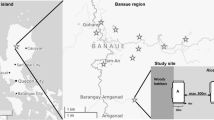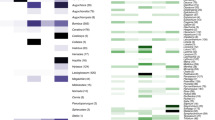Abstract
The current worldwide pollinator decline is caused by the interplay of different drivers. Several strategies have been undertaken to counteract or halt this decline, one of which is the implementation of wildflower fields. These supplementary flowers provide extra food resources and have proven their success in increasing pollinator biodiversity and abundance. Yet such landscape alterations could also alter the host–pathogen dynamics of pollinators, which could affect the populations. In this study, we investigated the influence of sown wildflower fields on the prevalence of micro-parasites and viruses in the wild bumble bee Bombus pascuorum, one of the most abundant bumble bee species in Europe and the Netherlands. We found that the effect of sown wildflower fields on micro-parasite prevalence is affected by the composition of the surrounding landscape and the size of the flower field. The prevalence of micro-parasites increases with increasing size of sown wildflower fields in landscapes with few semi-natural landscape elements. This effect was not observed in landscapes with a high amount of semi-natural landscape elements. We elaborate on two mechanisms which can support these findings: (1) “transmission hot spots” within the altered flower-networks, which could negatively impact hosts experiencing an increased exposure; (2) improved tolerance of the hosts, withstanding higher parasite populations.


Similar content being viewed by others
References
Arbetman MP et al (2012) Alien parasite hitchhikes to Patagonia on invasive bumblebee. Biol Invasions 15(3):489–494
Bates D, Mächler M, Bolker B, Walker S (2015) Fitting linear mixed-effects models using lme4. J Stat Softw 67(1):1–48
Brown MJF, Loosli R, Schmid-Hempel P (2000) Condition-dependent expression of virulence in a trypanosome infecting bumblebees. Oikos 91:421–427
Cable J et al (2017) Global change, parasite transmission and disease control: lessons from ecology. Philos Trans R Soc B Biol Sci 372(1719):20160088
Carvell C et al (2011) Bumble bee species’ responses to a targeted conservation measure depend on landscape context and habitat quality. Ecol Appl 21(5):1760–1771
Cisarovsky G, Schmid-Hempel P (2014) Combining laboratory and field approaches to investigate the importance of flower nectar in the horizontal transmission of a bumblebee parasite. Entomol Exp Appl 152(3):209–215
Colla SR et al (2006) Plight of the bumble bee: pathogen spillover from commercial to wild populations. Biol Cons 129(4):461–467
Di Pasquale G et al (2013) Influence of pollen nutrition on honey bee health: do pollen quality and diversity matter? Zeil J (ed) PLoS ONE 8(8):p.e72016
Durrer S, Schmid-Hempel P (1994) Shared use of flowers leads to horizontal pathogen transmission. Proc R Soc B Biol Sci 258(1353):299–302
Flenniken ML, Andino R (2013) Non-specific dsRNA-mediated antiviral response in the honey bee. G. Smagghe (ed) PLoS ONE 8(10): p.e77263
Fürst MA et al (2014) Disease associations between honeybees and bumblebees as a threat to wild pollinators. Nature 506(7488):364–366
Gallai N et al (2009) Economic valuation of the vulnerability of world agriculture confronted with pollinator decline. Ecol Econ 68(3):810–821
Geslin B et al (2017) Massively introduced managed species and their consequences for plant–pollinator interactions. Adv Ecol Res 57:147–199
Gisder S, Genersch E (2017) Viruses of commercialized insect pollinators. J Invertebr Pathol 147(July):51–59
Goulson D, Hughes WOH (2015) Mitigating the anthropogenic spread of bee parasites to protect wild pollinators. Biol Cons 191:10–19
Goulson D et al (2015) Bee declines driven by combined stress from parasites, pesticides, and lack of flowers. Science 347(6229):1255957
Graystock P, Goulson D, Hughes WOH (2015) Parasites in bloom: flowers aid dispersal and transmission of pollinator parasites within and between bee species. Proc R Soc B Biol Sci 282(1813):20151371
Graystock P et al (2016) Do managed bees drive parasite spread and emergence in wild bees? Int J Parasitol Parasites Wildl 5(1):64–75
Green P, MacLeod CJ (2016) SIMR: an R package for power analysis of generalized linear mixed models by simulation. Nakagawa S (ed) Methods Ecol Evol 7(4):493–498
Heard MS et al (2007) Landscape context not patch size determines bumble-bee density on flower mixtures sown for agri-environment schemes. Biol Let 3(6):638–641
Henson KSE, Craze PG, Memmott J (2009) The restoration of parasites, parasitoids, and pathogens to heathland communities. Ecology 90(7):1840–1851
Holdenrieder O et al (2004) Tree diseases and landscape processes: the challenge of landscape pathology. Trends Ecol Evol 19(8):446–452
Kleijn D et al (2018) Scaling up effects of measures mitigating pollinator loss from local- to landscape-level population responses. Carvalheiro L (ed) Methods Ecol Evol:1–12
Kleijn D, van Langevelde F (2006) Interacting effects of landscape context and habitat quality on flower visiting insects in agricultural landscapes. Basic Appl Ecol 7(3):201–214
Knigtht ME et al (2005) An interspecific comparison of foraging range and nest density of four bumblebee (Bombus) species. Mol Ecol 14(6):1811–1820
Lafferty KD (2012) Biodiversity loss decreases parasite diversity: theory and patterns. Philos Trans R Soc B Biol Sci 367(1604):2814–2827
Logan A et al (2005) The impact of host starvation on parasite development and population dynamics in an intestinal trypanosome parasite of bumble bees. Parasitology 130(6):637–642
McMenamin AJ, Genersch E (2015) Honey bee colony losses and associated viruses. Curr Opin Insect Sci 8:121–129
Meeus I et al (2010) Multiplex PCR detection of slowly-evolving trypanosomatids and neogregarines in bumblebees using broad-range primers. J Appl Microbiol 109(1):107–115
Meeus I et al (2011) Effects of invasive parasites on bumble bee declines. Conserv Biol 25(4):662–671
Menail AH et al (2016) Large pathogen screening reveals first report of Megaselia scalaris (Diptera: Phoridae) parasitizing Apis mellifera intermissa (Hymenoptera: Apidae). J Invertebr Pathol 137:33–37
R Core Team (2015) R: A language and environment for statistical computing. R Foundation for Statistical Computing, Vienna, Austria. https://www.R-project.org/
Ruiz-Gonzalez MX, Brown MJF (2006) Honey bee and bumblebee trypanosomatids: specificity and potential for transmission. Ecol Entomol 31(6):616–622
Scheper, J. et al., 2013. Environmental factors driving the effectiveness of European agri-environmental measures in mitigating pollinator loss - a meta-analysis J. Gomez, ed. Ecology Letters, 16(7), pp.912–920
Scheper J et al (2015) Local and landscape-level floral resources explain effects of wildflower strips on wild bees across four European countries. Diamond S (ed). J Appl Ecol 52(5):1165–1175
Sguazza GH et al (2013) Simultaneous detection of bee viruses by multiplex PCR. J Virol Methods 194(1–2):102–106
Steven JC et al (2003) Density-dependent pollinator visitation and self-incompatibility in upper great lakes populations of Trillium grandiflorum. J Torrey Bot Soc 130(1):23
Tscharntke T et al (2012) Landscape moderation of biodiversity patterns and processes—eight hypotheses. Biol Rev 87(3):661–685
Westphal C et al (2008) Measuring bee diversity in different European habitats and biogeographical regions. Ecol Monogr 78(4):653–671
Acknowledgements
This project was supported in part by the Ghent University and the Research Foundation-Flanders (FWO-Vlaanderen) for the Belgian team, and the team in the Netherlands by the Netherlands Organization for Scientific Research (NWO-ALW; Biodiversity Works Program, 841.11.001) and Syngenta. D.K. was additionally supported by EC FP7 project LIBERATION (311781; www.fp7liberation.eu) and EC COST Action SUPER-B (FA1307; http://www.superb-project.eu). We also thank Dr. Tibor Bukovinszky for his assistance.
Author information
Authors and Affiliations
Contributions
DK, GS and IM conceived the ideas and designed methodology; NP and TL collected the data; NP, IM and JS analyzed the data; NP and IM led the writing of the manuscript. All authors contributed critically to the drafts and gave final approval for publication.
Corresponding author
Ethics declarations
Conflict of interest
The authors declare that there is no conflict of interest.
Data accessibility
The data will be made publicly available at Dryad.
Additional information
Communicated by Candace Galen.
Electronic supplementary material
Below is the link to the electronic supplementary material.
Rights and permissions
About this article
Cite this article
Piot, N., Meeus, I., Kleijn, D. et al. Establishment of wildflower fields in poor quality landscapes enhances micro-parasite prevalence in wild bumble bees. Oecologia 189, 149–158 (2019). https://doi.org/10.1007/s00442-018-4296-y
Received:
Accepted:
Published:
Issue Date:
DOI: https://doi.org/10.1007/s00442-018-4296-y




